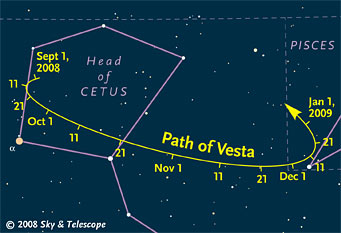Have you ever seen an asteroid? It's more fun — and much easier — than you might imagine. If you're new to the game, then Vesta, the brightest of the lot, is definitely the one to start with.
This is a great time to view Vesta, because the asteroid is directly opposite the Sun, and almost at its brightest and closest to Earth, on October 29, 2008. It remains quite bright through mid-November, then fades gradually toward the end of the year. But even on December 31st, Vesta will still shine brighter than any other asteroid ever gets throughout 2008.
Vesta is near the head of Cetus, which rises an hour or two after sunset in late October. You will get your best views when the asteroid is high in the sky, which won't happen for another couple of hours after that. But by late November, Vesta will already be quite high by the time the sky is fully dark.

Click above to download a printable, black-on-white PDF version of this chart.
Tony Flanders
In 2007, Vesta got just about as bright as it ever can, reaching magnitude 5.4. At that point, I could spot it easily from a dark location with just my unaided eyes. It will be much tougher to see naked-eye this year at its peak magnitude of 6.4. But it's a snap to find with binoculars. Just click here to download a printable chart in PDF format. Then locate the head of Cetus and start comparing what you see through the binoculars with what's printed on the chart. When you find a medium-faint "star" that isn't plotted on the chart but is on Vesta's track — you've found the asteroid! The chart shows stars to magnitude 7.5, Vesta's brightness in the last week of December.
What's so fun about viewing something that looks just like any normal 6th-magnitude star? To find that out, make a little sketch of how Vesta fits into the surrounding star field. Then come back a night or two later, look again, and you'll see that the asteroid has moved. Vesta is moving about ¼° per day, so its motion is quite obvious over a course of a few nights.
Through a telescope at medium to high magnification, Vesta's motion is obvious over much shorter time spans. The asteroid covers 0.6 arcminutes per hour, which is a substantial distance at 100×. Try it; I bet you'll like it!
 3
3









Comments
Charles Kuester
October 30, 2008 at 9:44 pm
I think you have a misprint in Vesta's hourly movement.
1/4 degree/day = 15'/day or 0.6 minutes of arc per hour not 0.6 degrees per hour.
I will try it, I'm sure I'll like it1
You must be logged in to post a comment.
Jerry Dougherty
November 16, 2008 at 7:35 pm
I have found an error in your basic leadin for the very good Vesta article, that you may want to change. It states that viewing is very good in the last 3 months of 2009, but believe you meant last three months of 2008, which you support by your evidence. Entire article is great, but I was confused for some time on exploring it, by the conflicting expectation I got from the picture representation.
You must be logged in to post a comment.
Jerry Dougherty
November 16, 2008 at 7:35 pm
I have found an error in your basic leadin for the very good Vesta article, that you may want to change. It states that viewing is very good in the last 3 months of 2009, but believe you meant last three months of 2008, which you support by your evidence. Entire article is great, but I was confused for some time on exploring it, by the conflicting expectation I got from the picture representation.
You must be logged in to post a comment.
You must be logged in to post a comment.